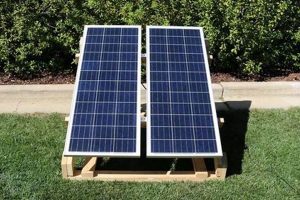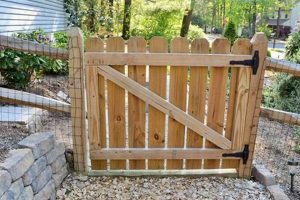A custom-designed media storage and display unit, integrated directly into a wall or structural recess, frequently characterizes a home enhancement project involving owner construction. These units offer tailored solutions for organizing electronics, media, and decorative items, often becoming a focal point within a living space. Examples range from simple shelving systems to complex cabinetry with integrated lighting and concealed wiring.
The appeal of these personalized structures lies in their space-saving potential and aesthetic contribution to a room’s design. Historically, such installations were the domain of professional carpenters and contractors. However, the increased availability of accessible building materials, detailed online resources, and user-friendly power tools has enabled homeowners to undertake these projects, resulting in cost savings and personalized design outcomes. Furthermore, these projects increase property value by providing sought-after features for home buyers.
This article explores essential elements for successful project completion, including planning considerations, material selection, construction techniques, and finishing details. Subsequent sections will provide guidance on navigating design challenges, maximizing storage efficiency, and ensuring structural integrity, ensuring a durable and visually appealing finished product.
Construction Recommendations
The following recommendations offer guidance for individuals undertaking the design and construction of media storage solutions integrated directly into the structure of a residence. Careful consideration of these points will contribute to a successful and enduring project.
Tip 1: Precise Dimensional Planning: Prior to material acquisition, meticulously measure the intended installation space. Account for existing architectural elements such as baseboards, crown molding, and wall irregularities. Accurate measurements are critical for a seamless fit and professional appearance.
Tip 2: Material Selection Based on Structural Requirements: Choose materials appropriate for the intended load-bearing capacity of the unit. Solid hardwoods offer superior strength and durability, but engineered wood products like plywood or MDF may provide a more cost-effective and dimensionally stable alternative for certain components. Research material properties to inform decisions.
Tip 3: Prioritize Structural Integrity: Ensure adequate support for shelves and other horizontal surfaces. Implement robust joinery techniques such as mortise-and-tenon, dovetail, or pocket-hole joinery to create strong and stable connections. Reinforce connections with screws and wood glue as appropriate.
Tip 4: Conceal Wiring and Cables: Integrate wire management solutions into the design to minimize visible cables. Plan for access points to facilitate connections to electronic devices. Employ cable raceways or concealed conduits to maintain a clean aesthetic and prevent damage to wiring.
Tip 5: Employ Leveling Techniques: During installation, utilize shims to ensure the unit is level and plumb. An unlevel unit can create visual distortions and compromise the functionality of drawers and doors. Precision leveling is essential for a professional finish.
Tip 6: Apply a Durable Finish: Select a finish appropriate for the intended use and environment. Consider factors such as moisture resistance, scratch resistance, and UV protection. Apply multiple coats of finish, sanding lightly between coats, to achieve a smooth and durable surface.
Tip 7: Consult Building Codes and Regulations: Before commencing construction, review local building codes and regulations to ensure compliance. This may include requirements for fire safety, electrical wiring, and structural integrity. Adherence to codes is essential for safety and legality.
Adherence to these recommendations, focusing on precise planning, robust construction, and attention to detail, will contribute to a media storage structure that enhances the functionality and aesthetic appeal of the space.
The subsequent section will address common challenges encountered during construction and strategies for overcoming them.
1. Precise Measurements
The initial and foundational step in any owner-constructed, integrated media storage solution involves meticulous dimensional assessment. Inaccurate measurements propagate errors throughout the project, influencing material acquisition, cutting accuracy, and ultimately, the overall fit and finish of the structure. A deviation of even a fraction of an inch can lead to gaps, misaligned components, and a compromised aesthetic. For example, if the available wall width is incorrectly measured, the entire framework may be too large or too small, requiring costly rework or complete reconstruction.
The importance of accurate dimensions extends beyond the initial framework. Shelving, drawers, and door sizes are all predicated on the overall dimensions of the unit. If the internal dimensions are incorrect, these components may not fit properly, hindering functionality. Furthermore, integrating existing electronic equipment necessitates precise measurement of device dimensions to ensure adequate space for proper ventilation and cable management. Overlooking this aspect can lead to overheating of electronics and restricted access to essential connections. Real-world scenarios frequently involve correcting mistakes due to incorrect measurements that result in material waste and project delays. Corrective actions can become costly and diminish the quality of the final product.
Therefore, rigorous attention to detail during the measurement phase is paramount. Multiple measurements, use of reliable measuring tools (levels and laser measurers are preferable), and documentation of dimensions are essential practices. Discrepancies should be investigated and resolved before proceeding to the next stage. Precise dimensional planning is not merely a preliminary task; it is an ongoing process that impacts every subsequent phase of the project. Its significance underscores the importance of prioritizing accuracy and thoroughness to ensure a successful integrated media storage installation.
2. Material Selection
Material selection represents a critical decision point in the creation of integrated media storage solutions. The chosen materials directly influence the structural integrity, aesthetic appeal, and longevity of the finished unit. Inadequate material selection can lead to premature failure, compromised functionality, and a diminished overall value. For example, utilizing low-density particleboard for load-bearing shelves will likely result in sagging and potential collapse under the weight of electronic equipment or media collections. Conversely, opting for solid hardwood throughout a project designed for minimal load-bea
ring requirements might represent an unnecessary expense and potentially contribute to design inflexibility due to wood’s inherent properties.
The connection between material choice and design success is multifaceted. Aesthetic considerations, such as wood grain, color, and texture, play a significant role in achieving the desired visual impact. A modern design might call for sleek, painted MDF surfaces, while a rustic aesthetic might necessitate the use of reclaimed wood with visible knots and imperfections. Beyond aesthetics, material properties directly affect construction techniques and long-term performance. Solid wood, for example, requires careful consideration of expansion and contraction due to changes in humidity, while engineered wood products offer greater dimensional stability. The selection of appropriate fasteners, adhesives, and finishing products is also predicated on the chosen materials. Failure to select compatible materials can lead to weakened joints, delamination of finishes, and accelerated degradation of the structure. Choosing the right material impacts the longevity of the unit, and choosing the wrong material can destroy it.
In summary, material selection is not merely a cosmetic decision but a fundamental aspect of integrated media storage construction. Careful consideration of structural requirements, aesthetic goals, construction techniques, and long-term performance is essential for achieving a durable, functional, and visually appealing finished product. A thorough understanding of material properties and their suitability for specific applications is paramount for preventing costly mistakes and ensuring the successful completion of the project. The selection process is often best addressed by researching, planning, and adjusting one’s design to account for material strength and composition.
3. Structural Integrity
The structural integrity of an owner-constructed, integrated media storage unit is paramount to its long-term functionality and safety. The correlation between robust construction and the capacity to support substantial weight from electronic equipment, media collections, and decorative items is direct. A failure to adequately account for load-bearing requirements can lead to sagging shelves, unstable frameworks, and potentially catastrophic collapse. For instance, an integrated unit constructed using insufficient joinery techniques or inadequate material thicknesses may exhibit signs of structural weakness within a relatively short period, especially when loaded with heavy components such as amplifiers or large-screen televisions. This degradation not only compromises the aesthetic appeal of the unit but also presents a safety hazard to occupants.
Furthermore, structural stability is closely linked to the long-term performance and usability of the integrated unit. Drawers, doors, and adjustable shelves require a rigid and stable framework to operate smoothly and without binding. A structure that lacks sufficient rigidity may experience warping, twisting, or settling over time, leading to misalignment and difficulty in accessing stored items. In contrast, a well-engineered and structurally sound unit will maintain its alignment and functionality for an extended lifespan, providing consistent and reliable performance. Consider the example of integrated drawer slides; if the supporting structure deviates from a perfectly square configuration, the slides will bind, making the drawer difficult to open and close.
In conclusion, the significance of structural integrity in an owner-constructed integrated media storage unit cannot be overstated. It is not merely a desirable attribute but a fundamental requirement for ensuring safety, functionality, and longevity. The selection of appropriate materials, the application of robust construction techniques, and adherence to sound engineering principles are all essential components of achieving a structurally sound and enduring media storage solution. Overlooking structural considerations ultimately jeopardizes the entire project, leading to potential hazards and diminished value. Therefore, rigorous attention to structural details is critical for any successful project.
4. Wiring Management
Effective wiring management is an indispensable component of any owner-constructed, integrated media storage solution. The haphazard routing and visibility of electrical cables and signal wires detract from the aesthetic appeal of the installation and present potential safety hazards. Poorly managed wiring can lead to cable entanglement, restricted airflow around electronic components, and an increased risk of electrical shock or fire. The integration of modern entertainment systems necessitates the accommodation of numerous power cords, HDMI cables, speaker wires, and network cables. Without a systematic approach to wiring, the rear of the unit can quickly become an unorganized and potentially hazardous mess.
Integrated media units require planning for concealed conduits or channels to route wires discreetly from the wall outlets to the electronic devices. Access panels or removable sections are crucial to facilitate future modifications, upgrades, and troubleshooting. Ignoring this aspect results in exposed cables, requiring unsightly methods of cable concealment after project completion. For example, pre-planning cable pathways to minimize cable bending radii is necessary, as tight bends can negatively affect signal quality, particularly in HDMI connections. Moreover, providing adequate ventilation around amplifiers and other heat-generating components is vital to prevent overheating and ensure equipment longevity. Clear labeling of cables at both ends also simplifies future maintenance and upgrades.
In conclusion, strategic wiring management is not merely a cosmetic consideration but a fundamental requirement for achieving a professional and functional integrated media storage solution. It enhances the aesthetic appeal of the installation, improves safety, and facilitates future maintenance and upgrades. A proactive approach to wiring management ensures that the unit seamlessly integrates into the living space, providing a clean, organized, and enjoyable entertainment experience. Without these considerations, issues will eventually arise causing damage to equipment, and or user harm from fire or electrocution.
5. Level Installation
Level installation forms a critical stage in the construction and integration of a homeowner-built media storage unit. A non-level installation introduces a cascade of adverse effects, impacting both the aesthetic appearance and the functional performance of the structure. Misalignment becomes immediately apparent, detracting from the intended visual appeal. Beyond aesthetics, unlevel shelves compromise stability, potentially causing items to slide or fall. Drawers and doors may bind or fail to operate smoothly if the unit lacks proper leveling. These issues intensify with heavier components, such as large televisions or collections of media. The result is a compromised user experience and a diminished value of the overall installation. Precision leveling is vital to mitigate those outcomes. This is a critical stage that needs time, patience, and accuracy during the installation phase. A level and squared built-
in ensures drawers, doors and other hardware components work properly and last longer.
Practical applications of accurate leveling extend beyond simple visual alignment. Integrated lighting systems may project uneven patterns if the supporting structure is not perfectly level. Speaker placement, often a component of an integrated media setup, relies on level surfaces to ensure optimal sound dispersion and minimize audio distortion. Furthermore, the long-term stability of the unit is dependent on a level foundation. Uneven weight distribution can place undue stress on certain structural elements, leading to accelerated wear and potential failure over time. Real-world projects often reveal the necessity of shimming and adjusting components to achieve a truly level installation. Without those adjustments, costly repairs may be needed as a result.
In conclusion, level installation transcends superficial considerations, directly impacting the functional performance, aesthetic appeal, and long-term stability of an integrated media storage solution. Addressing levelness during the install requires tools like bubble levels, laser levels, and shims, and careful attention to detail. Neglecting the leveling of the unit introduces structural weaknesses that will be magnified over time resulting in a flawed finished product that will be costly to repair, or the built-in will have to be completely replaced and removed. Taking careful consideration to ensure everything is precisely aligned is a crucial skill and step to do correctly when constructing a durable and visually impressive structure.
6. Durable Finish
The application of a durable finish is a critical element in the construction of an owner-built, integrated media storage unit. The finish protects the underlying material from environmental factors, wear, and tear, while also contributing significantly to the aesthetic appeal and longevity of the structure. The selection and proper application of a durable finish are therefore essential for ensuring a successful and enduring project.
- Protection Against Moisture and Humidity
An appropriate finish acts as a barrier against moisture penetration, preventing warping, swelling, and decay of wood or engineered wood products. This is particularly important in environments with fluctuating humidity levels, where unprotected materials are susceptible to dimensional changes and structural damage. For example, a polyurethane finish on a plywood media unit provides a water-resistant layer, safeguarding against spills and condensation.
- Resistance to Scratches and Abrasions
A durable finish protects the surface from scratches, scuffs, and abrasions caused by everyday use. This is crucial for maintaining the aesthetic appearance of the unit and preventing damage to the underlying material. A catalyzed varnish, for instance, provides a hard, scratch-resistant surface ideal for high-traffic areas or surfaces that frequently come into contact with objects.
- UV Protection and Color Stability
Certain finishes offer UV protection, preventing fading and discoloration of the material over time. This is particularly important for units exposed to direct sunlight, where unprotected surfaces can degrade and lose their original color. A UV-resistant lacquer, commonly used for furniture, effectively filters harmful UV rays, preserving the color and integrity of the finish.
- Enhanced Cleanability and Maintenance
A durable finish simplifies cleaning and maintenance, allowing for easy removal of dust, dirt, and stains. This ensures that the unit remains visually appealing and hygienic over its lifespan. A smooth, non-porous finish, such as conversion varnish, facilitates easy cleaning with common household cleaners and resists the absorption of spills, simplifying upkeep.
In summary, a durable finish extends the lifespan of the owner-built media storage unit while maintaining its visual appeal and functionality. Considering factors such as environmental conditions, usage patterns, and aesthetic preferences when selecting a finish ensures a successful and enduring installation. The proper application of finish significantly enhances both its value and aesthetic of the integrated media storage solution.
Frequently Asked Questions
This section addresses common inquiries regarding the design, construction, and installation of integrated media storage units. The responses aim to provide clarity and guidance for individuals considering undertaking such a project.
Question 1: Is a building permit required for constructing an integrated media storage unit?
Building permit requirements vary depending on local regulations. Generally, if the structure is permanently attached to the building’s framework and involves alterations to electrical or plumbing systems, a permit is likely necessary. Consult local building codes to ensure compliance.
Question 2: What is the best material for building the unit’s frame?
The selection of framing material depends on budget, design aesthetic, and structural requirements. Solid hardwoods offer superior strength and longevity, while engineered wood products, such as plywood or MDF, provide a more cost-effective and dimensionally stable alternative. Determine the material based on the load-bearing capacity requirements.
Question 3: How should wiring and cables be concealed?
Concealing wiring and cables involves strategic planning during the design phase. Incorporate conduits, raceways, or access panels to route wires behind the unit’s structure. Securely fasten cables to prevent sagging or tangling, and label them clearly for easy identification.
Question 4: What joinery techniques are recommended for constructing the unit?
Robust joinery techniques are essential for ensuring the structural integrity of the unit. Mortise-and-tenon, dovetail, and pocket-hole joinery are all viable options. Reinforce connections with screws and wood glue for added strength and stability.
Question 5: How can adequate ventilation for electronic equipment be ensured?
Adequate ventilation requires incorporating ventilation openings into the design. Position vents strategically near heat-generating components, such as amplifiers and receivers. Ensure sufficient clearance around electronic devices to allow for proper airflow.
Question 6: What type of finish is most suitable for an integrated media storage unit?
The selection of finish depends on the desired aesthetic and the intended use of the unit. Polyurethane, lacquer, and varnish are all durable options that provide protection against moisture, scratches, and UV damage. Select a finish compatible with the chosen construction material and apply it according to the manufacturer’s instructions.
These FAQs highlight key considerations for individuals contemplating a project. Thorough planning, adherence to building codes, and sound construction practices are essential for achieving a successful outcome.
The subsequent section will provide insights into troubleshooting common challenges encountered during the construction process.
Conclusion
This article has explored key considerations for constructing a diy built in entertainment center. Precise measurements, appropriate material selection, robust structural integrity, strategic wiring management, meticulous leveling, and the application of a durable finish have been i
dentified as critical factors influencing the success and longevity of such a project. The integration of these elements necessitates careful planning, diligent execution, and a thorough understanding of construction principles.
Successfully implementing these principles will provide a custom storage solution that enhances the functionality and aesthetic value of the living space. Readers considering such an undertaking are advised to prioritize thorough research, meticulous planning, and adherence to relevant building codes to ensure a safe and visually appealing final product. The commitment to quality craftsmanship yields lasting results.







